Geometrical Optics · Physics · JEE Advanced
MCQ (More than One Correct Answer)
Two identical concave mirrors each of focal length f are facing each other as shown in the schematic diagram. The focal length f is much larger than the size of the mirrors. A glass slab of thickness t and refractive index n_0 is kept equidistant from the mirrors and perpendicular to their common principal axis. A monochromatic point light source S is embedded at the center of the slab on the principal axis, as shown in the schematic diagram. For the image to be formed on S itself, which of the following distances between the two mirrors is/are correct:
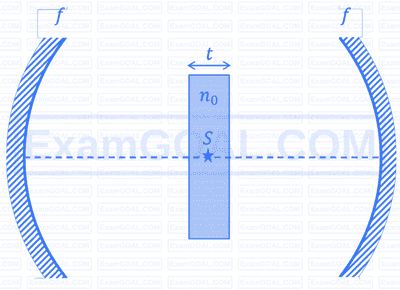
A glass beaker has a solid, plano-convex base of refractive index 1.60, as shown in the figure. The radius of curvature of the convex surface (SPU) is $9 \mathrm{~cm}$, while the planar surface (STU) acts as a mirror. This beaker is filled with a liquid of refractive index $n$ up to the level QPR. If the image of a point object $\mathrm{O}$ at a height of $h$ (OT in the figure) is formed onto itself, then, which of the following option(s) is(are) correct?



Three plane mirrors form an equilateral triangle with each side of length $L$. There is a small hole at a distance $l>0$ from one of the corners as shown in the figure. A ray of light is passed through the hole at an angle $\theta$ and can only come out through the same hole. The cross section of the mirror configuration and the ray of light lie on the same plane.

Which of the following statement(s) is(are) correct?
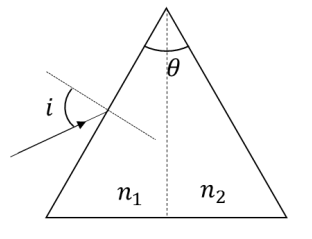


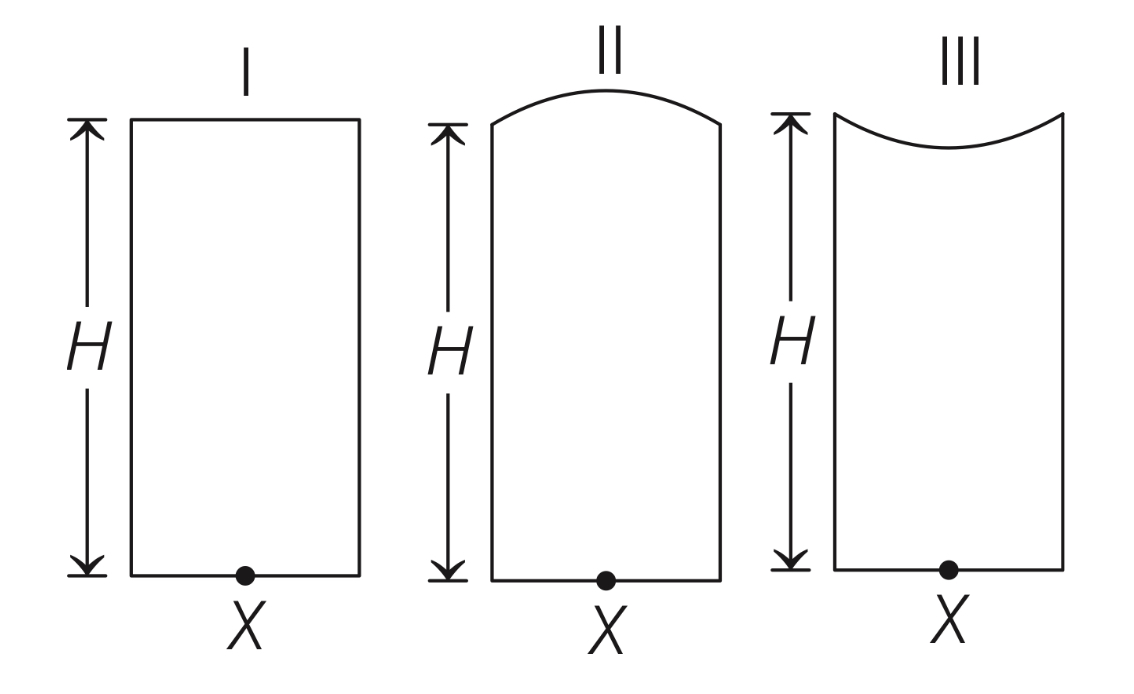
Cylinder I has a flat top, cylinder II has a convex top and cylinder III has a concave top. The radii of curvature of the two curved tops are same (R = 3 m). If H1, H2, and H3 are the apparent depths of a point X on the bottom of the three cylinders, respectively, the correct statement(s) is/are
Assuming $$\Delta $$n << (n - 1) and 1 < n < 2, the correct statement(s) is/are


Which of the following options is/are correct?

Which of the following statement(s) is (are) true?


A transparent thin film of uniform thickness and refractive index n1 = 1.4 is coated on the convex spherical surface of radius R at one end of a long solid glass cylinder of refractive index n2 = 1.5, as shown in the figure. Rays of light parallel to the axis of the cylinder traversing through the film from air to glass get focused at distance f1 from the film, while rays of light traversing from glass to air get focused at distance f2 from the film. Then
A ray OP of monochromatic light is incident on the face AB of prism ABCD near vertex B at an incident angle of 60$$^\circ$$ (see figure). If the refractive index of the material of the prism is $$\sqrt3$$, which of the following is(are) correct?

A student performed the experiment of determination of focal length of a concave mirror by $$u$$-$$v$$ method using an optical bench of length 1.5 m. The focal length of the mirror used is 24 cm. The maximum error in the location of the image can be 0.2 cm. The 5 sets of ($$u,v$$) values recorded by the student (in cm) are : (42, 56), (48, 48), (60, 40), (66, 33), (78, 39). The data set(s) that cannot come from experiment and is (are) incorrectly recorded, is (are)
Numerical
A solid glass sphere of refractive index $n=\sqrt{3}$ and radius $R$ contains a spherical air cavity of radius $\frac{R}{2}$, as shown in the figure. A very thin glass layer is present at the point 0 so that the air cavity (refractive index $n=1$ ) remains inside the glass sphere. An unpolarized, unidirectional and monochromatic light source $S$ emits a light ray from a point inside the glass sphere towards the periphery of the glass sphere. If the light is reflected from the point 0 and is fully polarized, then the angle of incidence at the inner surface of the glass sphere is $\theta$. The value of $\sin \theta$ is ________.

Two equilateral-triangular prisms $\mathrm{P}_1$ and $\mathrm{P}_2$ are kept with their sides parallel to each other, in vacuum, as shown in the figure. A light ray enters prism $\mathrm{P}_1$ at an angle of incidence $\theta$ such that the outgoing ray undergoes minimum deviation in prism $\mathrm{P}_2$. If the respective refractive indices of $\mathrm{P}_1$ and $\mathrm{P}_2$ are $\sqrt{\frac{3}{2}}$ and $\sqrt{3}$, then $\theta=\sin ^{-1}\left[\sqrt{\frac{3}{2}} \sin \left(\frac{\pi}{\beta}\right)\right]$, where the value of $\beta$ is ____.


Consider a configuration of $n$ identical units, each consisting of three layers. The first layer is a column of air of height $h=\frac{1}{3} \mathrm{~cm}$, and the second and third layers are of equal thickness $d=$ $\frac{\sqrt{3}-1}{2} \mathrm{~cm}$, and refractive indices $\mu_{1}=\sqrt{\frac{3}{2}}$ and $\mu_{2}=\sqrt{3}$, respectively. A light source 0 is placed on the top of the first unit, as shown in the figure. A ray of light from 0 is incident on the second layer of the first unit at an angle of $\theta=60^{\circ}$ to the normal. For a specific value of $n$, the ray of light emerges from the bottom of the configuration at a distance $l=\frac{8}{\sqrt{3}} \mathrm{~cm}$, as shown in the figure. The value of $n$ is ________.

An object and a concave mirror of focal length $f=10 \mathrm{~cm}$ both move along the principal axis of the mirror with constant speeds. The object moves with speed $V_{0}=15 \mathrm{~cm} \mathrm{~s}^{-1}$ towards the mirror with respect to a laboratory frame. The distance between the object and the mirror at a given moment is denoted by $u$. When $u=30 \mathrm{~cm}$, the speed of the mirror $V_{m}$ is such that the image is instantaneously at rest with respect to the laboratory frame, and the object forms a real image. The magnitude of $V_{m}$ is _________ $\mathrm{cm} \,\mathrm{s}^{-1}$.

A rod of length $2 \mathrm{~cm}$ makes an angle $\frac{2 \pi}{3} \mathrm{rad}$ with the principal axis of a thin convex lens. The lens has a focal length of $10 \mathrm{~cm}$ and is placed at a distance of $\frac{40}{3} \mathrm{~cm}$ from the object as shown in the figure. The height of the image is $\frac{30 \sqrt{3}}{13} \mathrm{~cm}$ and the angle made by it with respect to the principal axis is $\alpha$ rad. The value of $\alpha$ is $\frac{\pi}{n} r a d$, where $n$ is __________ .


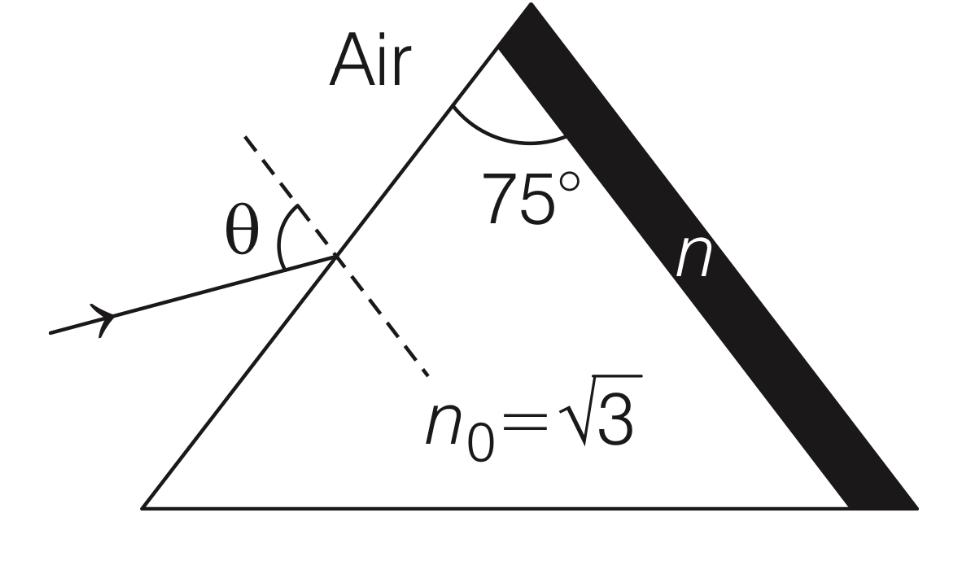
[Speed of light, c = 3 $$ \times $$ 108 m/s]



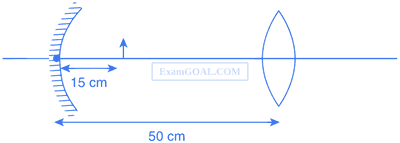
Water (with refractive index = 4/3) in a tank is 18 cm deep. Oil of refractive index 7/4 lies on water making a convex surface of radius of curvature R = 6 cm as shown. Consider oil to act a thin lens. An object S is placed 24 cm above water surface. The location of its image is at x cm above the bottom of the tank. Then x is __________.

A large glass slab ($$\mu$$ = 5/3) of thickness 8 cm is placed over a point source of light on a plane surface. It is seen that light emerges out of the top surface of the slab from a circular area of radius R cm. What is the value of R?
Image of an object approaching a convex mirror of radius of curvature 20 m along its optical axis is observed to move from $${{25} \over 3}$$ m to $${{50} \over 7}$$ m in 30 s. What is the speed of the object in km per hour?
The focal length of a thin biconvex lens is 20 cm. When an object is moved from a distance of 25 cm in front of it to 50 cm, the magnification of its image changes from m25 to m50. The ratio $${{{m_{25}}} \over {{m_{50}}}}$$ is __________.
MCQ (Single Correct Answer)
A light ray is incident on the surface of a sphere of refractive index $n$ at an angle of incidence $\theta_0$. The ray partially refracts into the sphere with angle of refraction $\phi_0$ and then partly reflects from the back surface. The reflected ray then emerges out of the sphere after a partial refraction. The total angle of deviation of the emergent ray with respect to the incident ray is $\alpha$. Match the quantities mentioned in List-I with their values in List-II and choose the correct option.
| List-I | List-II |
|---|---|
| (P) If $n = 2$ and $\alpha = 180^\circ$, then all the possible values of $\theta_0$ will be | (1) $30^\circ$ and $0^\circ$ |
| (Q) If $n = \sqrt{3}$ and $\alpha = 180^\circ$, then all the possible values of $\theta_0$ will be | (2) $60^\circ$ and $0^\circ$ |
| (R) If $n = \sqrt{3}$ and $\alpha = 180^\circ$, then all the possible values of $\phi_0$ will be | (3) $45^\circ$ and $0^\circ$ |
| (S) If $n = \sqrt{2}$ and $\theta_0 = 45^\circ$, then all the possible values of $\alpha$ will be | (4) $150^\circ$ |
| (5) $0^\circ$ |
List I contains four combinations of two lenses (1 and 2) whose focal lengths (in $\mathrm{cm}$ ) are indicated in the figures. In all cases, the object is placed $20 \mathrm{~cm}$ from the first lens on the left, and the distance between the two lenses is $5 \mathrm{~cm}$. List II contains the positions of the final images.
| List-I | List-II |
|---|---|
(I)  |
(P) Final image is formed at $7.5 \mathrm{~cm}$ on the right side of lens 2 . |
(II)  |
(Q) Final image is formed at $60.0 \mathrm{~cm}$ on the right side of lens 2 . |
(III)  |
(R) Final image is formed at $30.0 \mathrm{~cm}$ on the left side of lens $2 .$ |
(IV)  |
(S) Final image is formed at $6.0 \mathrm{~cm}$ on the right side of lens 2 . |
| (T) Final image is formed at $30.0 \mathrm{~cm}$ on the right side of lens 2 . |
Which one of the following options is correct?
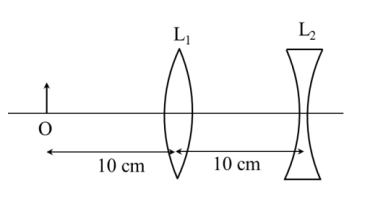
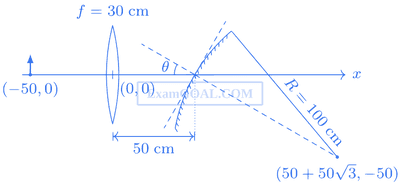
If the origin of the coordinate system is taken to be at the centre of the lens, the coordinates (in cm) of the point (x, y) at which the image is formed are

A point source S is placed at the bottom of a transparent block of height 10 mm and refractive index 2.72. It is immersed in a lower refractive index liquid as shown in the below figure. It is found that the light emerging from the block to the liquid forms a circular bright spot of diameter 11.54 mm on the top of the block. The refractive index of the liquid is

Four combinations of two thin lenses are given in List I. The radius of curvature of all curved surfaces is r and the refractive index of all the lenses is 1.5. Match lens combinations in List I with their focal length in List II and select the correct answer using the code given below the lists.

A right-angled prism of refractive index $$\mu$$1 is placed in a rectangular block of refractive index $$\mu$$2, which is surrounded by a medium of refractive index $$\mu$$3, as shown in the figure. A ray of light e enters the rectangular block at normal incidence. Depending upon the relationships between $$\mu$$1, $$\mu$$2 and $$\mu$$3, it takes one of the four possible paths 'ef', 'eg', 'eh' or 'ei'.

Match the paths in List I with conditions of refractive indices in List II and select the correct answer using the codes given below the lists:
| List I | List II | ||
|---|---|---|---|
| P. | $$e \to f$$ |
1. | $${\mu _1} > \sqrt 2 {\mu _2}$$ |
| Q. | $$e \to g$$ |
2. | $${\mu _2} > {\mu _1}$$ and $${\mu _2} > {\mu _3}$$ |
| R. | $$e \to h$$ |
3. | $${\mu _1} = {\mu _2}$$ |
| S. | $$e \to i$$ |
4. | $${\mu _2} < {\mu _1} < \sqrt 2 {\mu _2}$$ and $${\mu _2} > {\mu _3}$$ |
A ray of light travelling in the direction $${1 \over 2}\left( {\widehat i + \sqrt 3 \widehat j} \right)$$ is incident on a plane mirror. After reflection, it travels along the direction $${1 \over 2}\left( {\widehat i - \sqrt 3 \widehat j} \right)$$. The angle of incidence is
For light incident from air on a meta-material, the appropriate ray diagram is
Choose the correct statement.
A biconvex lens is formed with two planoconvex lenses as shown in the figure. Refractive index n of the first lens is 1.5 and that of the second lens is 1.2. Both curved surface are of the same radius of curvature R = 14 cm. For this biconvex lens, for an object distance of 40 cm, the image distance will be

A biconvex lens of focal length 15 cm is in front of a plane mirror. The distance between the lens and the mirror is 10 cm. A small object is kept at a distance of 30 cm from the lens. The final image is
Two transparent media of refractive indices $\mu_1$ and $\mu_3$ have a solid lens shaped transparent material of refractive index $\mu_2$ between them as shown in figures in Column II. A ray traversing these media is also shown in the figures. In Column I different relationships between $\mu_1, \mu_2$ and $\mu_3$ are given. Match them to the ray diagram shown in Column II :


A ball is dropped from a height of 20 m above the surface of water in a lake. The refractive index of water is 4/3. A fish inside the lake, in the line of fall of the ball, is looking at the ball. At an instant, when the ball is 12.8 m above the water surface, the fish sees the speed of ball as (Take g = 10 m/s$$^2$$)
A light beam is travelling from Region I to Region IV (Refer figure). The refractive index in Regions I, II, III and IV are $${n_0},{{{n_0}} \over 2},{{{n_0}} \over 6}$$ and $${{{n_0}} \over 8}$$, respectively. The angle of incidence $$\theta$$ for which the beam just misses entering Region IV is

An optical component and an object S placed along its optic axis are given in Column I. The distance between the object and the component can be varied. The properties of images are given in Column II. Match all the properties of images from Column II with the appropriate components given in Column I. Indicate your answer by darkening the appropriate bubbles of the 4 $$\times$$ 4 matrix given in the ORS.
| Column I | Column II | ||
|---|---|---|---|
| (A) |  |
(P) | Real Image |
| (B) |  |
(Q) | Virtual Image |
| (C) |  |
(R) | Magnified Image |
| (D) |  |
(S) | Image at infinity |
Two beams of red and violet colours are made to pass separately through a prism (angle of the prism is 60$$^\circ$$). In the position of minimum deviation, the angle of refraction will be :
Light travels as a
The phases of the light wave at $$c, d, e$$ and $$f$$ are $$\phi_c, \phi_d, \phi_{e}$$ and $$\phi_{f}$$ respectively.
It is given that $$\phi_{c} \neq \phi_{f}$$.